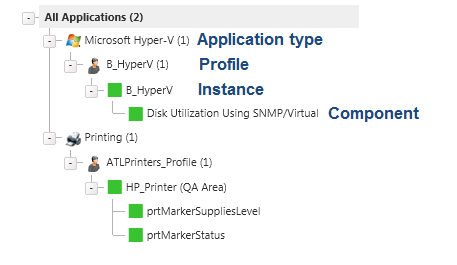Learning about APM terminology
The following terms are used throughout Application Performance Monitor:
- Application Type. Groups application profiles, instances, and components by the type of application (e.g. SQL Server, IIS, Windows 2008 Server). After profiles, instances, and components are configured for an application, you will begin monitoring information about application health.

- Application Profile. An application profile is a blueprint for monitoring a given type of application within APM. It defines the collection of components and distinct applications that reflect the health and status of a specific type of application. An application instance is created from the application profile by associating it with the actual devices that host the components of the application as defined by the application profile. Changes to the application profile are inherited by all of the instances created from the profile. Changes in the profile are not inherited by overridden fields.
- Application Instance. An application instance is a running copy of an application profile that monitors the defined collection of components, distinct applications, and thresholds necessary to define the health and performance of a given type of application. An application instance can extend the application profile by adding components, component groups, or discrete applications. The application profile is not changed when an application instance is extended.
- Component. A component is a single data point that is collected as part of an application profile. Example: CPU Utilization.
- Critical component. A critical component is a component that impacts the status of an application instance. As a result, a critical component that goes into the down state, causes the application instance to go into the down state. However, if a non-critical component goes into a down state, the application instance goes into a warning state and only the component indicates being in the down state.
- Critical component group. A critical component group is a grouping of components that contains specific logic to allow for complex evaluation of the up/down state of an application. For example, given four components A,B,C and D, the following logic can be applied, so that if A and B are down or C and D are down the application is placed into the down state. ((A and B) or (C and D)). Critical component groups are always considered "critical", in that if a critical component group is evaluated to be in the down state, the entire application is in the down state.
- Application. An application is made up of one or more programs running on one or more monitored systems.
- Simple application. A simple application is an application that is not dependent on another application to run. Example: Microsoft Server 2008 R2.
- Complex application. A complex application is an application configured to be dependent on one or more applications to run. Example: WhatsUp Gold (requires IIS and SQL Server).
- Discrete application. A discrete application is an application upon which a complex application has a dependency. For example, IIS and SQL Server are discrete applications on which the complex application WhatsUp Gold is dependent. A discrete application is used when you are monitoring a complex application.